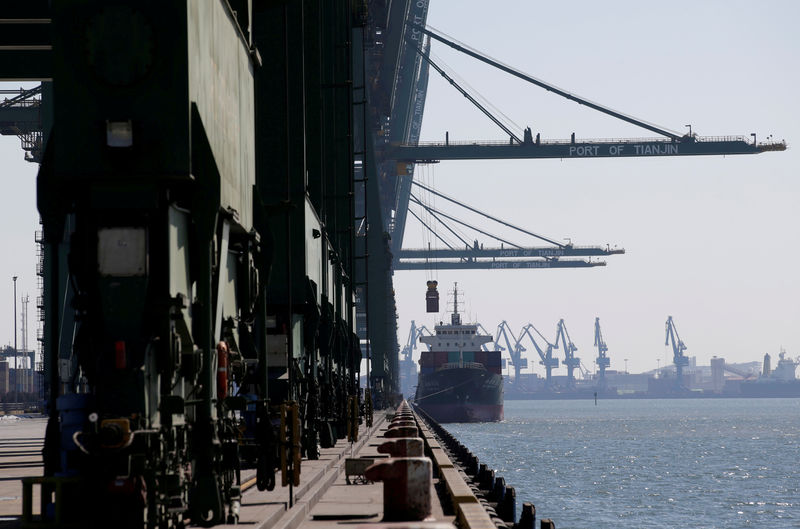 © Reuters. FILE PHOTO: A container is carried away from a cargo ship at Tianjin Port
© Reuters. FILE PHOTO: A container is carried away from a cargo ship at Tianjin PortBEIJING (Reuters) – China’s economy is expected to cool this year as a government-led crackdown on debt risks and factory pollution drag on overall activity, a Reuters poll showed on Tuesday.
Beijing is in the second year of a relentless campaign to wean China off its debt-heavy investment model, clamping down on everything from speculative property lending to shadow-bank financing activities as policy makers look to foster sustainable longer term growth.
That has pushed up borrowing costs and taken some of the momentum off the world’s second-largest economy, especially in the final months of 2017, with growth forecast at 6.5 percent this year, according to economists from 70 institutions surveyed by Reuters.
It was slightly above the poll’s October forecast of 6.4 percent expansion, but would still lag the survey’s 2017 projection of a 6.8 percent gross domestic product increase.
A government-led infrastructure spending spree, which partly contributed to better-than-expected growth last year, may “fare below expectations” due to tighter financial scrutiny, said Zhang Yiping, an analyst with China Merchant Securities.
A crackdown on factory pollution, which has shaved industrial output, is also expected to dent the broader economy.”Probably you’re going have a compounding impact on growth from all these piecemeal policies,” said Qu Hongbin, Greater China Chief Economist at HSBC.
“Separately they all look great, but when you put that together at the same time, you may end up with even greater downward pressure on growth than the policymakers like to see.”
China will keep its target for economic growth at “around 6.5 percent” in 2018, unchanged from last year, policy sources have told Reuters. The country will announce Q4 and 2017 GDP growth on Thursday.
Analysts expect the People’s Bank of China (PBOC) to keep its benchmark lending rate unchanged at 4.35 percent through at least the second quarter of 2019, the Reuters poll showed.
They have, however, pushed back their expectations on a cut in the amount of cash that banks are required to hold as reserves – the reserve requirement ratio (RRR).
The central bank is forecast to cut the RRR for all banks by 25 basis points (bps) in the fourth quarter of 2018 to 16.75 percent, versus the October poll’s prediction for a 50-bps cut in the second quarter this year.
The poll predicted annual consumer inflation to be more pronounced at 2.3 percent in 2018, up from the 2.2 percent estimated in the October survey due to rising services prices. The higher rate could remain through to 2019, the poll showed.
TRADE TAILWIND, PROTECTIONISM RISKS
On the whole, the forecasts back broad consensus of a gradual, rather than a sharp, slowdown in growth as authorities focus on turning off China’s years-long addiction to cheap money without imperiling the economy.
A resilient real estate market, which has slowed due to curbs on risky lending practices, could be a drag on the economy this year, analysts say.
At a key twice-a-decade Communist Party Congress last October, President Xi Jinping said China has entered a new era where it looks to move from high-speed to high-quality growth to achieve moderate prosperity.
A synchronized uptick in global growth, which has driven a worldwide trade boom and benefited China and other export-reliant nations over the past year, is expected to continue supporting the Asian giant. As well, a consumption boost from the rising numbers of Chinese to the middle class rank is seen providing a counterweight to some weakness in investment growth, analysts say.
Trade protectionism is one of the risks that could play out in the year ahead.
“While we remain comfortable about China’s export outlook for 2018, there are still uncertainties about Sino-US trade ties which may suddenly erupt,” Betty Wang, a Hong Kong-based analyst at ANZ, wrote in a note.
(For other stories from the Reuters global economic poll)
Source: Investing.com





























